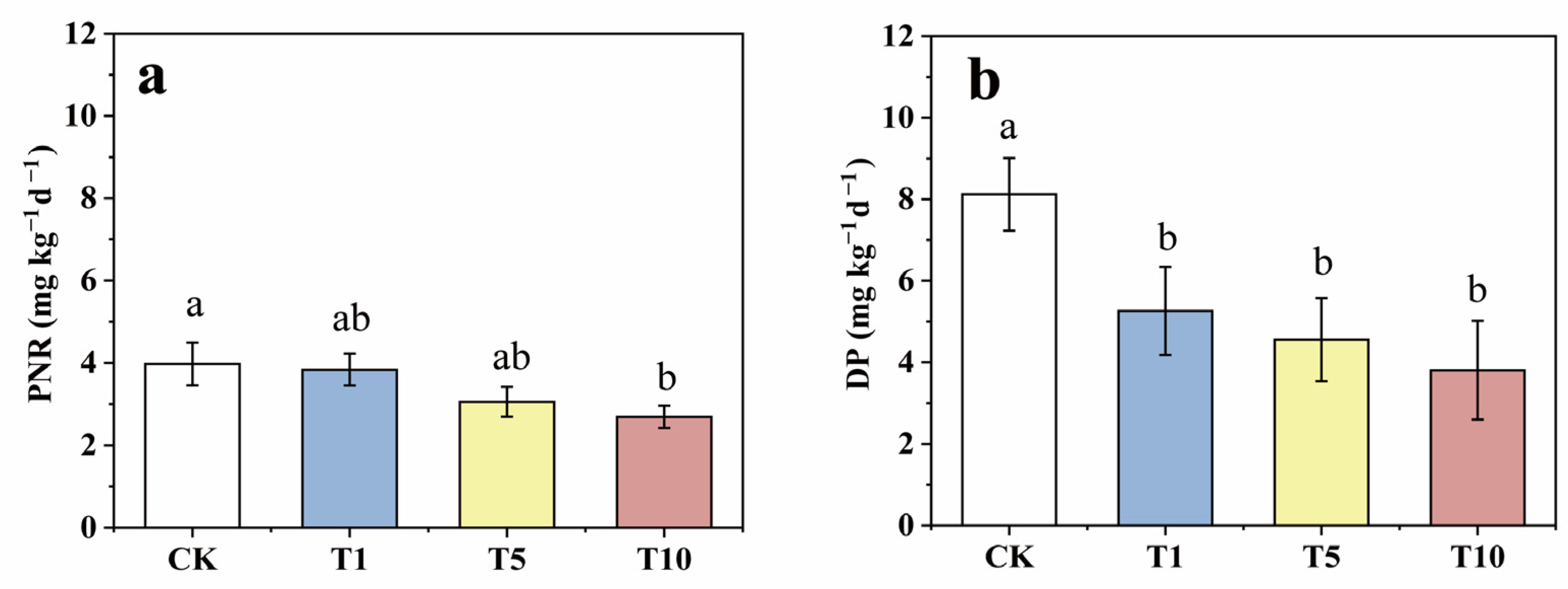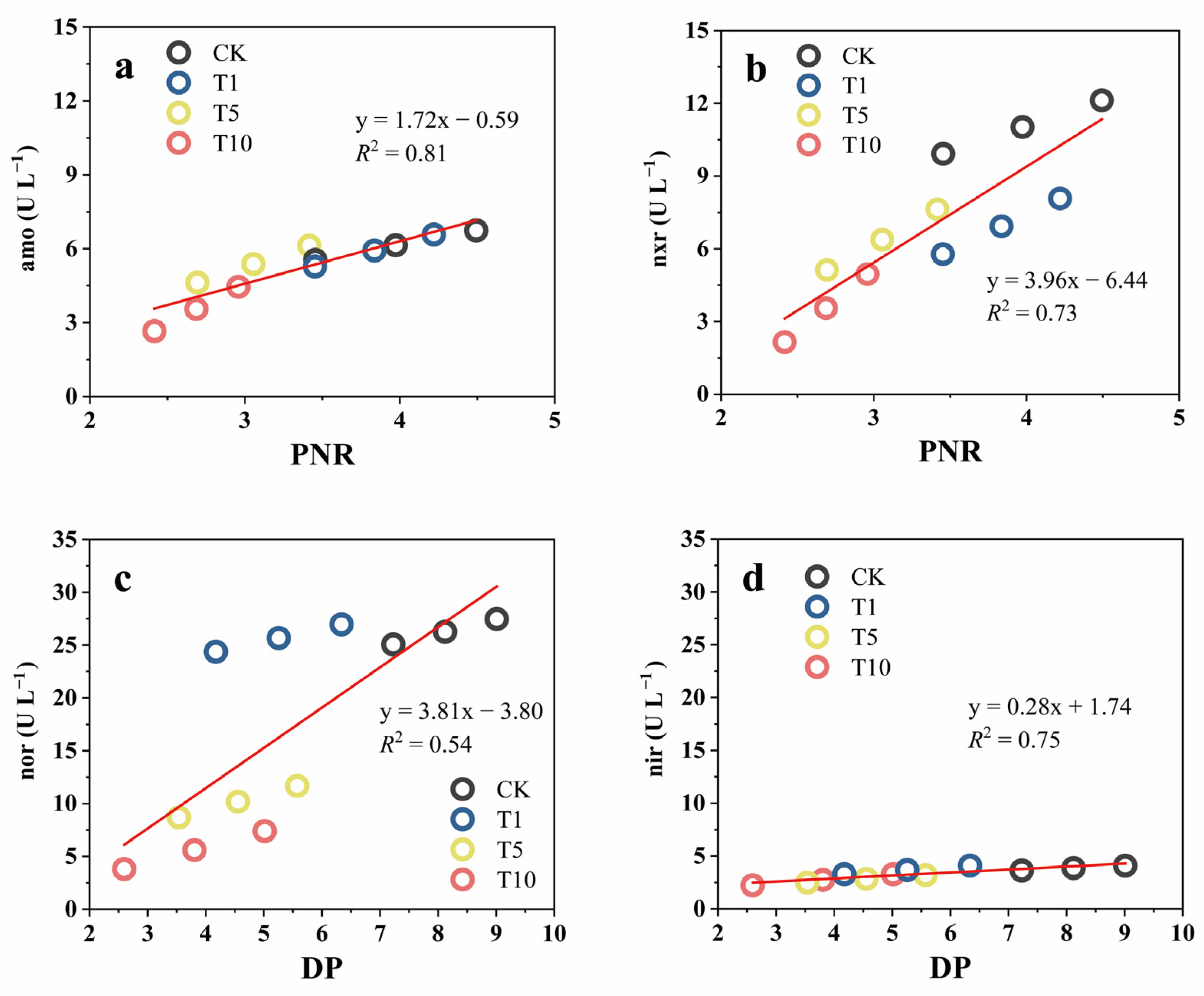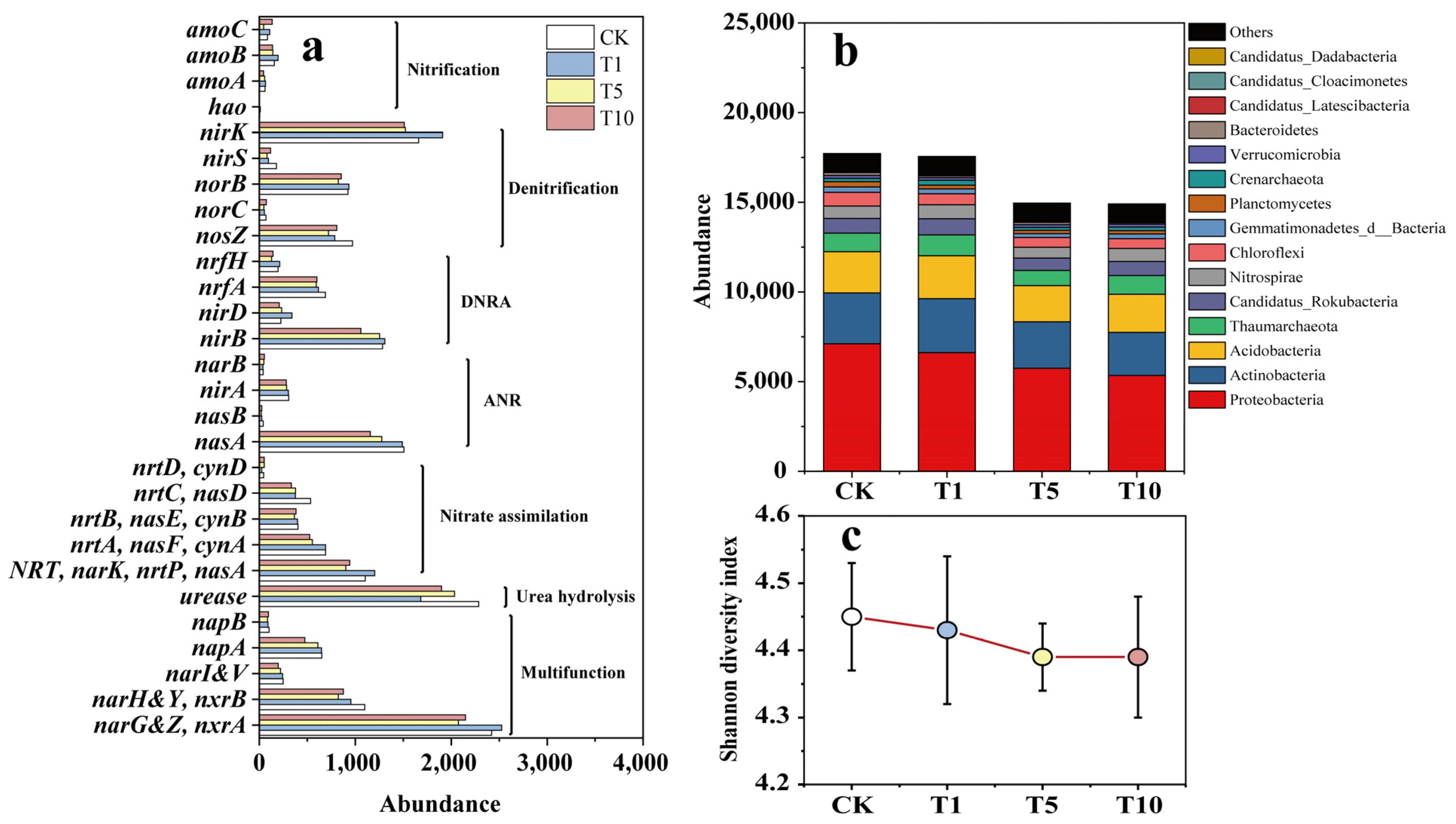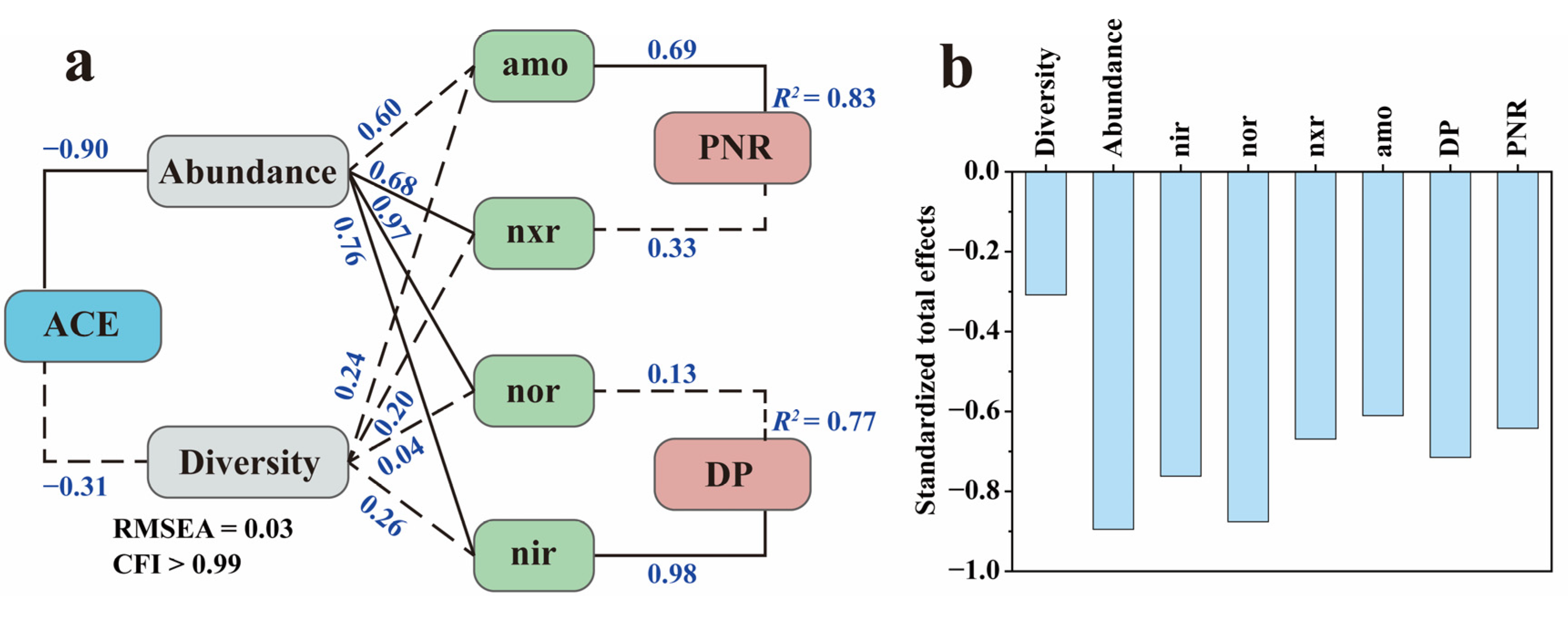Impacts of Acetochlor on Nitrogen-Cycling-Related Microbial Communities in Riparian Zone Soils
Abstract
1. Introduction
2. Materials and Methods
2.1. Soil Sample
2.2. Experimental Setup
- A 50 g soil sample (dry weight) was placed into a 500 mL brown-amber glass jar.
- Three levels of ACE (T1, T5, and T10) were dissolved in 10 mL of sterilized water and then added to a 500 mL brown-amber glass jar containing 50 g of the soil sample. The blank control group only contained 10 mL of sterilized water.
- All soil solutions were mixed for 10 min on a vortex mixer (MX-S/MX-F, Dragon Laboratory Instruments Limited) until homogenized.
- A 200 g soil sample (dry weight) was added to each jar.
- Samples were mixed again for 30 min with periodic shaking to ensure sufficient mixing.
- The soil moisture was maintained at 60% of the maximum soil moisture capacity using sterilized water, and the jar mouth was covered with a breathable sealing film.
- The jars were incubated in the incubator at 25 °C and 60% humidity.
- Sterilized water was replenished every 10 days during the experiment to maintain soil moisture for all treatments.
2.3. Potential Nitrification Rate and Denitrification Potential of Riparian Soils
2.4. Enzyme Assays
2.4.1. Extraction of the Enzyme Solutions
2.4.2. Enzyme Activity Assays
2.5. Metagenomic Sequencing and Bioinformatic Analysis
2.6. Statistical Analysis
3. Results and Discussion
3.1. N Transformation in Response to ACE
3.2. PNR, DP, and Enzymatic Activity in Response to ACE
3.3. N-Cycling Functional Genes and Microbial Communities in Response to ACE
3.4. Relationships between N Transformation Rate, Enzyme Activity, and the Microbial Community under the Influence of ACE
4. Conclusions
Author Contributions
Funding
Data Availability Statement
Acknowledgments
Conflicts of Interest
References
- Galloway, J.N.; Townsend, A.R.; Erisman, J.W.; Bekunda, M.; Cai, Z.; Freney, J.R.; Martinelli, L.A.; Seitzinger, S.P.; Sttton, M.A. Transformation of the nitrogen cycle: Recent trends, questions, and potential solutions. Science 2008, 320, 889–892. [Google Scholar] [CrossRef]
- Hefting, M.M.; Bobbink, R.; Janssens, M.P. Spatial variation in denitrification and N2O emission in relation to nitrate removal efficiency in an-stressed riparian buffer zone. Ecosystems 2006, 9, 550–563. [Google Scholar] [CrossRef]
- Friedman, E.S.; McPhillips, L.E.; Werner, J.J.; Poole, A.C.; Ley, R.E.; Walter, M.T.; Angenent, L.T. Methane emission in a specific riparian-zone sediment decreased with bioelectrochemical manipulation and corresponded to the microbial community dynamics. Front. Microbiol. 2015, 6, 1523. [Google Scholar] [CrossRef]
- Groffman, P.M.; Boulware, N.J.; Zipperer, W.C.; Pouyat, R.V.; Band, L.E.; Colosimo, M.F. Soil nitrogen cycle processes in urban riparian zones. Environ. Sci. Technol. 2002, 36, 4547–4552. [Google Scholar] [CrossRef] [PubMed]
- Kim, H.; Bae, H.S.; Ramesh, K.R.; Ogram, A. Distributions, abundances and activities of microbes associated with the nitrogen cycle in riparian and stream sediments of a river tributary. Water Res. 2016, 106, 51–61. [Google Scholar] [CrossRef]
- Hayakawa, A.; Nakata, M.; Jiang, R.; Kuramochi, K.; Hatano, R. Spatial variation of denitrification potential of grassland, windbreak forest, and riparian forest soils in an agricultural catchment in eastern Hokkaido, Japan. Ecol. Eng. 2012, 47, 92–100. [Google Scholar] [CrossRef]
- Valkama, E.; Usva, K.; Saarinen, M.; Uusi-Kämppä, J. A meta-analysis on nitrogen retention by buffer zones. J. Environ. Qual. 2018, 48, 270–279. [Google Scholar] [CrossRef] [PubMed]
- Lyu, C.J.; Li, X.J.; Yuan, P.; Song, Y.H.; Gao, H.J.; Liu, R.X.; Yu, H.B. Nitrogen retention effect of riparian zones in agricultural areas: A meta-analysis. J. Clean. Prod. 2021, 315, 128143. [Google Scholar] [CrossRef]
- Otto, S.; Cardinali, A.; Marotta, E.; Paradisi, C.; Zanin, G. Effect of vegetative filter strips on herbicide runoff under various types of rainfall. Chemosphere 2012, 88, 113–119. [Google Scholar] [CrossRef]
- Janssen, M.; Frings, J.; Lennartz, B. Effect of grass buffer strips on nitrate export from a tile-drained field site. Agric. Water Manag. 2018, 208, 318–325. [Google Scholar] [CrossRef]
- Gene, S.M.; Hoekstra, P.F.; Hannam, C.; White, M.; Truman, C.; Hanson, M.L.; Prosser, R.S. The role of vegetated buffers in agriculture and their regulation across Canada and the United States. J. Environ. Manag. 2019, 243, 12–21. [Google Scholar] [CrossRef] [PubMed]
- Su, X.; Chen, Y.; Wang, Y.; Yang, X.; He, Q. Impacts of chlorothalonil on denitrification and N2O emission in riparian sediments: Microbial metabolism mechanism. Water Res. 2019, 148, 188–197. [Google Scholar] [CrossRef] [PubMed]
- Bicalho, S.T.T.; Langenbach, T.; Rodrigues, R.R.; Correia, F.V.; Hagler, A.N.; Matallo, M.B.; Luchini, L.C. Herbicide distribution in soils of a riparian forest and neighboring sugar cane field. Geoderma 2010, 158, 392–397. [Google Scholar] [CrossRef]
- Sun, X.Y.; Zhou, Q.X.; Wang, Y.Y.; Ren, W.J. Influence of hydro-geomorphology, land-use and riparian zone characteristics on herbicide occurrence and distribution in sediments in Songhua River Basin, northeastern China. Geoderma 2013, 194, 56–164. [Google Scholar] [CrossRef]
- Aguiar, T.; Bortolozo, F.R.; Hansel, F.A.; Rasera, K.; Ferreira, M.T. Riparian buffer zones as pesticide filters of no-till crops. Environ. Sci. Pollut. Res. 2015, 22, 10618–10626. [Google Scholar] [CrossRef]
- Vidon, P. Riparian zone management and environmental quality: A multicontaminant challenge. Hydrol. Process. 2010, 24, 1532–1535. [Google Scholar] [CrossRef]
- Li, Y.; Liu, X.; Wu, X.; Dong, F.; Xu, J.; Pan, X.; Zheng, Y. Effects of biochars on the fate of acetochlor in soil and on its uptake in maize seedling. Environ. Pollut. 2018, 241, 710–719. [Google Scholar] [CrossRef]
- Zhang, Y.; Hu, Y.; An, N.; Jiang, D.; Cao, B.; Jiang, Z.; Yan, Y.W.; Ming, C.S.; Meng, Q.J.; Han, W. Short-term response of soil enzyme activities and bacterial communities in black soil to a herbicide mixture: Atrazine and Acetochlor. Appl. Soil Ecol. 2023, 181, 104652. [Google Scholar] [CrossRef]
- Liu, J.W.; Zhang, X.; Xu, J.Y.; Qiu, J.G.; Zhu, J.C.; Cao, H.; He, J. Anaerobic biodegradation of acetochlor by acclimated sludge and its anaerobic catabolic pathway. Sci. Total Environ. 2020, 748, 141122. [Google Scholar] [CrossRef]
- Liu, H.P.; Wang, X.H.; Ou, Y.; Cheng, L.; Hou, X.; Yan, L.M. Characterization of acetochlor degradation and role of microbial communities in biofilters with varied substrate types. Chem. Eng. J. 2023, 467, 143417. [Google Scholar] [CrossRef]
- Wang, S.S.; Zhang, Y.; Gao, J.F.; Zhang, J.D.; Tao, L.M.; Xu, W.P. The enantioselective study of the toxicity effects of chiral acetochlor in HepG2 cells. Ecotoxicol. Environ. Saf. 2021, 218, 112261. [Google Scholar] [CrossRef] [PubMed]
- Huang, H.; Xiong, Z.T. Toxic effects of cadmium, acetochlor and bensulfuron-methyl on nitrogen metabolism and plant growth in rice seedlings. Pestic. Biochem. Phys. 2009, 94, 64–67. [Google Scholar] [CrossRef]
- Yu, J.H.; Zhang, J.; Zheng, X.Z.; Zhang, Y.S.; Chen, D.L.; Ding, H. Divergent modulation of land use-driven changes in soil properties and herbicide acetochlor application on soil nitrogen cycling. Soil Till. Res. 2022, 215, 105231. [Google Scholar] [CrossRef]
- Yuan, S.G.; Zhang, W.Q.; Li, W.Y.; Li, Z.H.; Wu, M.S.; Shan, B.Q. Shifts in the bacterial community caused by combined pollutant loads in the North Canal River, China. J. Environ. Sci. 2023, 127, 541–551. [Google Scholar] [CrossRef]
- Li, X.; Hou, L.; Liu, M.; Zheng, Y.; Yin, G.; Lin, X.; Cheng, L.; Li, Y.; Hu, X. Evidence of nitrogen loss from anaerobic ammonium oxidation coupled with ferric iron reduction in an intertidal wetland. Environ. Sci. Technol. 2015, 49, 11560–11568. [Google Scholar] [CrossRef]
- Phogat, V.; Cox, J.W.; Kookana, R.S.; Šimůnek, J.; Pitt, T.; Fleming, N. Optimizing the riparian zone width near a river for controlling lateral migration of irrigation water and solutes. J. Hydrol. 2019, 570, 637–646. [Google Scholar] [CrossRef]
- Fan, F.; Zhang, F.; Lu, Y. Linking plant identity and interspecific competition to soil nitrogen cycling through ammonia oxidizer communities. Soil Biol. Biochem. 2011, 43, 46–54. [Google Scholar] [CrossRef]
- Xiong, Z.; Li, S.; Yao, L.; Liu, G.; Zhang, Q.; Liu, W. Topography and land use effects on spatial variability of soil denitrification and related soil properties in riparian wetlands. Ecol. Eng. 2015, 83, 437–443. [Google Scholar] [CrossRef]
- Hu, X.; Wang, Y.; Su, X.; Chen, Y. Acute response of soil denitrification and N2O emissions to chlorothalonil: A comprehensive molecular mechanism. Sci. Total Environ. 2018, 636, 1408–1415. [Google Scholar] [CrossRef]
- Chen, S.; Zhou, Y.; Chen, Y.; Gu, J. Fastp: An ultra-fast all-in-one FASTQ preprocessor. Bioinformatics 2018, 34, i884–i890. [Google Scholar] [CrossRef] [PubMed]
- Noguchi, H.; Park, J.; Takagi, T. MetaGene: Prokaryotic gene finding from environmental genome shotgun sequences. Nucl. Acid. Res. 2006, 34, 5623–5630. [Google Scholar] [CrossRef]
- Li, W.Z.; Godzik, A. Cd-hit: A fast programfor clustering and comparing large sets of protein or nucleotide sequences. Bioinformatics 2006, 22, 1658–1659. [Google Scholar] [CrossRef]
- Peng, Y.; Leung, H.C.M.; Yiu, F.Y.L.; Chin, F.Y.L. IDBA-UD: A de novo assembler for single-cell and metagenomic sequencing data with highly uneven depth. Bioinformatics 2012, 28, 1420–1428. [Google Scholar] [CrossRef]
- Altschul, S.F.; Madden, T.L.; Schäffer, A.A.; Zhang, J.; Zhang, Z.; Miller, W.; Lipman, D.J. Gapped BLAST and PSI-BLAST: A new generation of protein database search programs. Nucl. Acid. Res. 1997, 25, 3389–3402. [Google Scholar] [CrossRef]
- Zheng, Y.L.; Hou, L.J.; Liu, M.; Newell, S.E.; Yin, G.Y.; Yu, C.D.; Zhang, H.L.; Li, X.F.; Gao, D.Z.; Gao, J.; et al. Effects of silver nanoparticles on nitrification and associated nitrous oxide production in aquatic environments. Sci. Adv. 2017, 3, e1603229. [Google Scholar] [CrossRef] [PubMed]
- Ofek-Lalzar, M.; Sela, N.; Goldman-Voronov, M.; Green, S.J.; Hadar, Y.; Minz, D. Niche and host-associated functional signatures of the root surface microbiome. Nat. Commun. 2014, 5, 4950. [Google Scholar] [CrossRef]
- Yu, C.; Huang, X.; Chen, H.; Godfray, H.C.J.; Wright, J.S.; Hall, J.W.; Gong, P.; Ni, S.; Qiao, S.; Huang, G.; et al. Managing nitrogen to restore water quality in China. Nature 2019, 567, 516–520. [Google Scholar] [CrossRef] [PubMed]
- Ju, X.T.; Kou, C.L.; Zhang, F.S.; Christie, P. Nitrogen balance and groundwater nitrate contamination: Comparison among three intensive cropping systems on the North China Plain. Environ. Pollut. 2006, 143, 117–125. [Google Scholar] [CrossRef]
- Gai, X.; Liu, H.; Liu, J.; Zhai, L.; Wang, H.; Yang, B.; Ren, T.; Wu, S.; Lei, Q. Contrasting impacts of long-term application of manure and crop straw on residual nitrate-N along the soil profile in the North China Plain. Sci. Total Environ. 2019, 650, 2251–2259. [Google Scholar] [CrossRef]
- Du, Z.K.; Zhu, Y.Y.; Zhu, L.S.; Zhang, J.; Li, B.; Wang, J.H.; Wang, J.; Zhang, C.; Cheng, C. Effects of the herbicide mesotrione on soil enzyme activity and microbial communities. Ecotox. Environ. Saf. 2018, 164, 571–578. [Google Scholar] [CrossRef] [PubMed]
- Holzem, R.M.; Stapleton, H.M.; Gunsch, C.K. Determining the ecological impacts of organic contaminants in biosolids using a high-throughput colorimetric denitrification assay: A case study with antimicrobial agents. Environ. Sci. Technol. 2014, 48, 1646–1655. [Google Scholar] [CrossRef] [PubMed]
- Crouzet, O.; Batisson, I.; Besse-Hoggan, P.; Bonnemoy, F.; Bardot, C.; Poly, F.; Bohatier, J.; Mallet, C. Response of soil microbial communities to the herbicide mesotrione: A dose-effect microcosm approach. Soil Biol. Biochem. 2015, 42, 193–202. [Google Scholar] [CrossRef]
- Bonfleur, E.J.; Tornisielo, V.L.; Regitano, J.B.; Lavorenti, A. The effects of glyphosate and atrazine mixture on soil microbial population and subsequent impacts on their fate in a tropical soil. Water Air Soil Pollut. 2015, 226, 21. [Google Scholar] [CrossRef]
- Chen, Q.; Yang, B.; Wang, H.; He, F.; Gao, Y.; Scheel, R.A. Soil microbial community toxic response to atrazine and its residues under atrazine and lead contamination. Environ. Sci. Pollut. Res. 2015, 22, 996–1007. [Google Scholar] [CrossRef]
- Gao, J.; Song, P.; Wang, G.; Wang, J.; Zhu, L.; Wang, J. Responses of atrazinedegradation and native bacterial community in soil to Arthrobacter sp. strain HB-5. Ecotoxicol. Environ. Saf. 2018, 159, 317–323. [Google Scholar] [CrossRef]
- Singh, R.P.; Ahsan, M.; Mishra, D.; Pandey, V.; Anupama; Yadav, A.; Khare, P. Ameliorative effects of biochar on persistency, dissipation, and toxicity of atrazine inthree contrasting soils. J. Environ. Manag. 2022, 303, 114146. [Google Scholar] [CrossRef]
- Kuypers, M.M.M.; Marchant, H.K.; Kartal, B. The microbial nitrogen-cycling network. Nat. Rev. Microbiol. 2018, 16, 263–276. [Google Scholar] [CrossRef]
- Singh, S.; Kumar, V.; Chauhan, A.; Datta, S.; Wani, A.B.; Singh, N.; Singh, J. Toxicity, degradation and analysis of the herbicide atrazine. Environ. Chem. Lett. 2017, 16, 211–237. [Google Scholar] [CrossRef]







| Physicochemical Parameters | Values |
|---|---|
| pH | 7.4 |
| MS | 19.31% |
| SOM | 23.37 mg g−1 |
| TP | 0.68 mg g−1 |
| NH3−-N | 0.97 mg kg−1 |
| NO3−-N | 25.41 mg kg−1 |
| NO2−-N | 0.37 mg kg−1 |
| TC | 18.2 mg g−1 |
| TN | 0.53 mg g−1 |
| KEGG Genes | Abundance (T10/CK) | t Value | p-Value | ACE Effect |
|---|---|---|---|---|
| narG, narZ, nxrA | −11.24 | 3.63 | 0.022 | Negative |
| narH, narY, nxrB | −20.22 | 6.83 | 0.002 | Negative |
| narI, narV | −20.16 | 6.81 | 0.002 | Negative |
| napA | −27.30 | 9.54 | 0.001 | Negative |
| napB | −5.88 | 1.85 | 0.138 | Nonsignificant |
| urease | −16.97 | 5.64 | 0.005 | Negative |
| NRT, narK, nrtP, nasA | −14.67 | 4.82 | 0.008 | Negative |
| nrtA, nasF, cynA | −23.77 | 8.17 | 0.001 | Negative |
| nrtB, nasE, cynB | −5.45 | 1.71 | 0.162 | Nonsignificant |
| nrtC, nasD | −37.83 | 13.88 | 0.000 | Negative |
| nrtD, cynD | 8.70 | −2.54 | 0.064 | Nonsignificant |
| nasA | −23.24 | 7.97 | 0.001 | Negative |
| nasB | −35.00 | 12.68 | 0.000 | Negative |
| nirA | −8.50 | 2.71 | 0.054 | Nonsignificant |
| narB | 30.00 | −7.91 | 0.001 | Positive |
| nirB | −17.60 | 5.87 | 0.004 | Negative |
| nirD | −7.14 | 2.26 | 0.086 | Nonsignificant |
| nrfA | −12.79 | 4.17 | 0.014 | Negative |
| nrfH | −27.55 | 9.64 | 0.001 | Negative |
| nosZ | −16.87 | 5.61 | 0.005 | Negative |
| norC | 2.86 | −0.86 | 0.438 | Nonsignificant |
| norB | −7.58 | 2.40 | 0.074 | Nonsignificant |
| nirS | −33.71 | 12.14 | 0.000 | Negative |
| nirK | −9.04 | 2.89 | 0.045 | Negative |
| hao | −100.00 | 43.22 | 0.000 | Negative |
| amoA | −26.67 | 9.29 | 0.001 | Negative |
| amoB | −11.54 | 3.73 | 0.020 | Negative |
| amoC | 39.52 | −9.66 | 0.000 | Positive |
| Phylum | Abundance (T10/CK) | t Value | p-Value | ACE Effect |
|---|---|---|---|---|
| Proteobacteria | −24.85 | 6.88 | 0.002 | Negative |
| Actinobacteria | −15.09 | 3.99 | 0.016 | Negative |
| Acidobacteria | −7.80 | 1.99 | 0.118 | Negative |
| Thaumarchaeota | 1.56 | −0.38 | 0.724 | Nonsignificant |
| Candidatus_Rokubacteria | −4.85 | 1.22 | 0.290 | Nonsignificant |
| Nitrospirae | 4.02 | −0.97 | 0.389 | Nonsignificant |
| Chloroflexi | −28.04 | 7.88 | 0.001 | Negative |
| Gemmatimonadetes_D__Bacteria | −13.16 | 3.44 | 0.026 | Negative |
| Planctomycetes | −37.93 | 11.16 | 0.000 | Negative |
| Crenarchaeota | 5.26 | −1.26 | 0.278 | Nonsignificant |
| Verrucomicrobia | 1.23 | −0.30 | 0.779 | Nonsignificant |
| Bacteroidetes | −50.65 | 15.73 | 0.000 | Negative |
| Candidatus_Latescibacteria | −48.28 | 14.85 | 0.000 | Negative |
| Candidatus_Cloacimonetes | 30.77 | −6.47 | 0.003 | Positive |
| Candidatus_Eisenbacteria | −41.67 | 12.47 | 0.000 | Negative |
Disclaimer/Publisher’s Note: The statements, opinions and data contained in all publications are solely those of the individual author(s) and contributor(s) and not of MDPI and/or the editor(s). MDPI and/or the editor(s) disclaim responsibility for any injury to people or property resulting from any ideas, methods, instructions or products referred to in the content. |
© 2024 by the authors. Licensee MDPI, Basel, Switzerland. This article is an open access article distributed under the terms and conditions of the Creative Commons Attribution (CC BY) license (https://creativecommons.org/licenses/by/4.0/).
Share and Cite
Lyu, C.; Cui, J.; Jin, F.; Li, X.; Xu, Y. Impacts of Acetochlor on Nitrogen-Cycling-Related Microbial Communities in Riparian Zone Soils. Water 2024, 16, 461. https://doi.org/10.3390/w16030461
Lyu C, Cui J, Jin F, Li X, Xu Y. Impacts of Acetochlor on Nitrogen-Cycling-Related Microbial Communities in Riparian Zone Soils. Water. 2024; 16(3):461. https://doi.org/10.3390/w16030461
Chicago/Turabian StyleLyu, Chunjian, Jianglong Cui, Fangyuan Jin, Xiaojie Li, and Yaning Xu. 2024. "Impacts of Acetochlor on Nitrogen-Cycling-Related Microbial Communities in Riparian Zone Soils" Water 16, no. 3: 461. https://doi.org/10.3390/w16030461
APA StyleLyu, C., Cui, J., Jin, F., Li, X., & Xu, Y. (2024). Impacts of Acetochlor on Nitrogen-Cycling-Related Microbial Communities in Riparian Zone Soils. Water, 16(3), 461. https://doi.org/10.3390/w16030461





